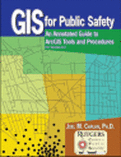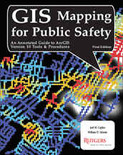This book focuses on ESRI’s ArcGIS functionality (the most popular GIS software, worldwide) and presents many of the tools and techniques that are commonly used by public safety researchers, analysts, and practitioners. It gives simple steps for descriptive, exploratory, and explanatory mapping tasks and includes concise but meaningful discussions to let you critically assess and accurately apply the software to your own unique specialty. This provides a solid foundation for advanced spatial thinking and permits you to utilize GIS technology in your own innovative ways. Its comprehensive content makes it the perfect coursebook or reference manual for students, researchers, crime analysts, and other GIS users at all skill levels.
To use a construction metaphor, this book is intended to teach a carpenter what tools are in his toolbox and how to use them. This instills confidence in his ability to apply these tools to any job when needed. Other books teach the carpenter specifically how to build a house. However, skills needed to build a house might fail the carpenter when he needs to build furniture instead. GIS for Public Safety focuses on a complete working knowledge of the toolbox to let the carpenter accurately apply the tools to his or her own unique specialty. BOOK OVERVIEW Part I: Introduction PREFACE CH 1: Introduction to Mapping and ArcGIS Part II: Making Maps with Existing Data CH 2: Communicating with Maps CH 3: Map Design and Layout CH 4: Spatial Data Sources, Projections, and GIS Data Management Part III: Managing and Editing Spatial Data CH 5: Geocoding Addresses and Working with XY Data CH 6: Spatial and Tabular Joins CH 7: Working with Attribute Tables CH 8: Georectifying and Digitizing Part IV: Analyzing Spatial Data CH 9: ArcToolbox and Geoprocessing CH 10: Spatial Analyst Tools, Density Mapping, and 3D Modeling CH 11: Identifying Significant Patterns and Hot Spots |
This book focuses on Esri’s ArcGIS functionality and presents many of the tools and techniques commonly used by public safety researchers, analysts, and practitioners. It gives simple steps for descriptive, exploratory, and explanatory mapping tasks and includes concise but meaningful discussions to let you critically assess and accurately apply the software to your own unique specialty. This provides a solid foundation for advanced spatial thinking and permits you to utilize geographic information systems (GIS) technology in your own innovative ways. Its comprehensive content makes it the perfect coursebook or reference manual for GIS users at all skill levels.
BOOK OVERVIEW PREFACE How to Use This Book PC or MAC? CH 1: Introduction to Mapping and ArcGIS CH 2: Communicating with Maps CH 3: Map Design and Layout CH 4: Spatial Data and Map Projections CH 5: Geocoding Addresses and Working with XY Data CH 6: Spatial and Tabular Joins CH 7: Working with Attribute Tables CH 8: Georectifying and Digitizing CH 9: ArcToolbox and Geoprocessing CH 10: Spatial Analyst Tools, Density Mapping, and 3D Modeling CH 11: Identifying Significant Patterns and Hot Spots CH 12: Online Mapping and ArcGIS.com |
Instructor Materials
A model syllabus, lab assignments, lab data, and a lab grading guide are available for free download. Click Here
A model syllabus, lab assignments, lab data, and a lab grading guide are available for free download. Click Here
Reviews
“Ready? Fire! … now Aim. In trying to teach a set of new techniques, this can actually be good advice. Take a shot, check the target, learn what you will, and take another shot. It works and, ironically enough, it works especially well as the strategy employed in GIS for Public Safety. By presenting most of his material in the form of immediately-executable steps, Caplan is able to guide his reader in a manner that is remarkably efficient, demonstrably effective, and ultimately quite enjoyable.” C. Dana Tomlin | Professor and originator of map algebra
“Dr. Caplan's GIS for Public Safety embodies his unique blend of skills and experience in teaching, GIS, and public safety. He demystifies what can be a frustrating process of learning to make GIS software do what students of GIS want it to do and offers a series of practical tips for making sure that maps communicate effectively.” Amy Hillier | Professor and author
“The author's use of illustration and screen capture allows for complex and oftentimes cumbersome mapping procedures to be conducted and understood by the reader with little difficulty. This book will allow for fellow map-makers and practitioners alike to either build new spatially-oriented skills or to increase and fine tune their existing abilities.” Michael Ostermann | Research Scientist, NJ State Parole Board
“I'm very impressed with this manual -- the steps in GIS analysis are very clearly laid out and explained.” Ronald V. G. Clarke | Distinguished criminologist


